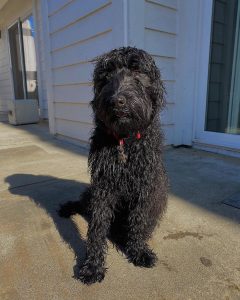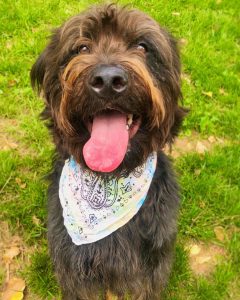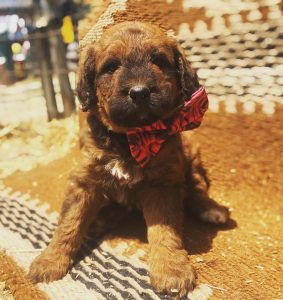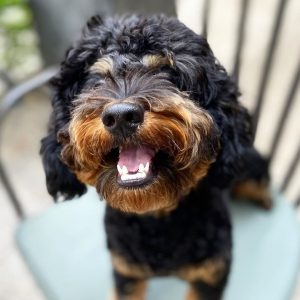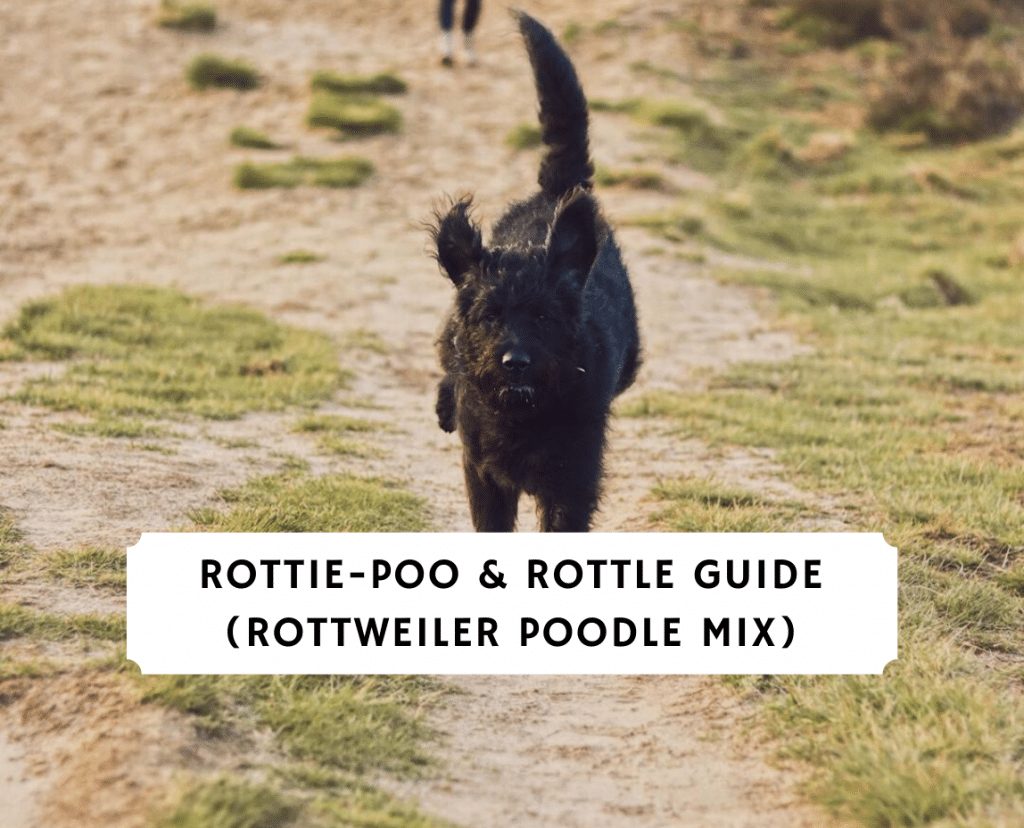
A Rottie-poo, also known as the Rottle, Rottiepoo, or Rottweiler Poodle mix, is a dog breed that is a mix between the Rottweiler and the Poodle. The Rottie-poo is one of the most trending Doodle dog types on the planet since they are constantly happy, eager to please their owners, and get along with almost any human or pet. Furthermore, the Rottie-poo has fantastic hereditary attributes that make their coat nonshedding and hypoallergenic. You won’t be vacuuming your floors all the time and you’ll be sneezing a lot less. Last but not least, people like to get a Rottie-poo because they look like a large black teddy bear.
Considering that the Rottie-poo is a crossbred pet, it will certainly be available in several different sizes as well as coat colors. These are highly sociable dogs with high energy, but they also like to cuddle. Due to the fact the Rottie-poo is a really friendly pet dog, they are considered easy to train, great with youngsters, as well as enjoyable to be around. We hope you learn something about this upcoming Rottie-poo doodle breed!
Table of Contents
What is a Rottie-poo dog?
The Rottie-poo is a crossbred pet dog that is a mix of two extremely prominent dog types: the Rottweiler (either American Rottweiler or English Rottweiler) and also the Poodle. The Rottweiler, as well as Poodle, are rather different dogs in terms of temperament and individuality, yet they integrate to make one of the prettiest pet dog breeds in the world. The Rottie-poo is the same dog breed as the Rottle.
The Rottle is one of the larger doodle types and is great for those who want a larger size dog. Larger sized dogs tend to make you feel more protected and make great companions for hikes and outdoor activities. The Rottie-poo comes in several different coat colors that highly depends on the parent Poodle coat color.
Rottie-poo Background
The exact origin of the Rottie-poo is truly unknown, however, we do know that they were bred sometime during the early 2000s. The idea of the doodle pet dog originated in the 1980s when Wally Conron attempted to create a Labradoodle for a visually impaired family pet owner that experienced allergic reactions. Doodles not only were great for dog allergies, but they also don’t shed any hair. In addition, they make great guide dogs because they are easy to train with a mild temperament. The Rottweiler Poodle mix is just one type of doodle dog!
Rottweiler History
The Rottweiler is a large dog breed that originated out of Germany and is one of the oldest dog breeds in the entire world. The earliest known origin of the Rottweiler is A.D. 74 as they were part of the Roman Army. Rottweilers were originally called the Rottweiler Metzgerhound which stood for the “Rottweiler butcher dog.”
This is primarily because they used to pull carts full of butcher’s meat to the market in Germany. The Rottweiler also used to herd livestock and hunt birds like waterfowl. The Rottweiler breed was originally recognized by the AKC in 1935. These are giant dogs as females usually stand between 70 to 100 pounds and males can get up to 130 pounds.
Poodle History
The Poodle was first seen in a 15th century drawing from a German musician that attempted to paint the future of the world, which included Poodles. Since then, the Poodle has actually progressed from being a hunting, farming, as well as bird hunting to more of a domesticated dog. The Poodle is also fantastic at swimming because their coat tends to float in the water. They used to retrieve animals from the water after being shot by hunters.
Today the Poodle is the 7th most popular pet dog type in the world primarily because they are hypoallergenic and also nonshedding pets. There are so many different colors and sizes of the Poodle that it heavily dictates what the Rottie-poo is going to look like.
The Rottie-poo Pet Dog Breed
This Rottweiler Poodle mix is an exceptional doodle pet breed. However, since they are a crossbreed dog, they aren’t officially acknowledged by the AKC. Thus, there is really no regulation of the Rottweiler Poodle. Because the Rottle has grown in popularity there are several different sizes as well as various coat colors. We will go over the most common sizes and colors.
Mini Rottle Size
The Mini Rottle size is the smallest size that breeders will make. A mini Rottie-poo will vary in weight from 30 to 45 pounds. Despite being called a “mini” these dogs are still quite big relative to the normal dog size. However, there is no official standardized size and breeders are free to label any size Rottie-poo a mini. The mini Rottle is great for people who want a Rottweiler Poodle mix that isn’t going to be too large.
Standard Rottle Size
The standard Rottle size is the largest of this canine breed. Generally, standard Rottie-poo’s will be anywhere from 50 to 90 pounds depending on what size Poodle they were bred with. However, it is possible for a Rottle to exceed 100 pounds — these dogs get big! You’ll want to have a larger yard and live an active lifestyle if you get a standard sized Rottle. They are quite an active dog breed that loves to play fetch and run around.
Rottie-poo Colors
There are many different Rottie-poo colors considering that the Poodle has 10 standard color types. In addition, the Rottweiler can also come in several different coat colors. The most common types of Rottle colors are listed below:
Black Rottie-poo Color
A solid black Rottie-poo is the most popular color since the Rottweiler is typically black and brown. When a Rottweiler is bred with a black Poodle, the result is typically a pure black Rottle. In this particular case, the brown coloring of a Rottweiler is considered a recessive gene. When you get a black Rottle, they tend to also have black eyes and black nails in addition to their coat color. If you’re looking for a big black teddy bear then a black Rottie-poo might be the perfect dog for you.
Black and Brown Rottie-Poo Color
Despite brown being a recessive gene, you will see black and brown Rottie-poo’s. This multi-colored dog usually does cost a little bit more than a solid color, but they are gorgeous looking. Typically their body is dominated by the black color, but you will see brown spots near their chest area, lower feet area, and sometimes facial area. Typically the black and brown Rottiepoo will also have black eyes, black nails, and black paw pads. Multi-colored Rottweiler Poodle mixes are considered rarer than a solid color.
Rottie-poo Grooming
The Rottie-poo normally does not shed had which means that you will have to groom this dog breed. Every 6 to 12 weeks, you’ll have to take this dog to a groomer or give them a haircut yourself.
In addition to haircuts, you’ll have to brush your Rottie-poo dog at least a few times a week to prevent their fur from tangling and matting. If your Rottle dog establishes a lot of tangles, you’ll have to shave your dog completely. Rottie-poo grooming isn’t too difficult once you practice. You essentially tradeoff vacuuming a bunch of hair off your house floor for having to groom and brush your dog.
Rottie-poo Life Expectancy
Rottles should easily live over ten years as long as they are well-taken care of with regular exercise and mental stimulation. Given that Rottie-poo pets are a crossbred canine, they inherit a unique hereditary called Hybrid Vigor. Hybrid Vigor simply indicates that a crossbred pet is less likely to inherit diseases that are passed along from a purebred canine. This is why Rottles will typically have a longer life expectancy.
Rottweiler Poodle Mix Generations
Breeders use complex terms to describe the generation of Rottie-poo dogs that you are purchasing. Oftentimes, breeders will say F1B Rottiepoo’s or F1 Rottiepoo’s. The letter “F” stands for filial which simply means the Rottle is a crossbred pet dog instead of a purebred dog. The number (1 or 2 or 3) is the generation of the Rottle. The letter “B” represents backcrossed, which indicates that it was bred with a 100% purebred dog – usually the Poodle. The genetic makeup of each Rottweiler Poodle mix is listed below:
- F1 Rottiepoo: 50% Poodle as well as 50% Rottweiler.
- F1B Rottiepoo: 75% Poodle as well as 25% Rottweiler.
- F1BB Rottiepoo: 87.5% Poodle as well as 12.5% Rottweiler.
- F2 Rottiepoo: 50% Poodle as well as 50% Rottweiler.
- F2B Rottiepoo: 62.5% Poodle as well as 37.5% Rottweiler.
- F2BB Rottiepoo: 81.25% Poodle as well as 18.75% Rottweiler.
- F3 Rottiepoo or Multi-gen Rottiepoo: Numerous generations of Rottweiler and Poodle breeding generally backcrossed to the Poodle.
Please reference our Doodle Generations Guide for more in-depth knowledge. Generally, people purchase Rottle dogs that have a significant quantity of Poodle genetics since they shed less and are more hypoallergenic.
Should I get a Rottweiler Poodle mix?
Rottie-poos are an excellent dog to get if you’re looking for a larger doodle that is sweet, wise, and trains fast. They likewise acquire some pretty solid hereditary characteristics due to the fact that they don’t shed and are allergy-friendly pets.
However, there are various other downsides to the Rottweiler and Poodle mix. Rottie-poo’s need to be groomed every 12 or so weeks to avoid mattes and also tangles in their fur. That consists of daily brushing, routine haircuts, and regular cutting of their nails. This will certainly take up a lot of your time to keep your Rottiepoo happy and healthy. Second, the Rottweiler Poodle mix has lots of energy and will require regular daily exercise. You’ll want to make sure that you live a relatively active lifestyle as these dogs don’t like to sit around. Overall, Rottie-poo’s are great dogs though!
Frequently Asked Questions
Does the Rottiepoo shed?
Are Rottie Poos protective?
Yes, Rottie Poos are protective dogs that are very loyal to their owners. While this is a benefit to many owners, it can also be a drawback for some. Rottie Poos are not only protective, but they’re also daunting to others who don’t know them.
Some people will misunderstand your dog and think that they look much more aggressive than they actually are. This is because Rottweilers have a stigma against them that they are aggressive dogs.
However, this is not always the case. Just because a Rottie Poo is protective, doesn’t mean they are aggressive or dangerous.
Despite this, some insurance companies consider the Rottweiler to be an aggressive breed and therefore won’t write homeowners insurance or renters insurance policies to their owners. While this doesn’t always apply to mixed breeds, it could also have an impact on you if you have a Rottie Poo.
Rottie Poos make good guard dogs because they can remain alert to any threat coming near to you or your house. Correct training will need to be carried out to ensure that they remain protective without jumping to aggressive tendencies.
How big do Rottie Poos get?
The Rottie Poo is a relatively new breed and therefore the average size of them can vary greatly. A few more years of documented data about the breed needs to be carried out before we can accurately say how large a Rottie Poo will get.
However, with the data that we currently do possess, Rottie Poos grow to be medium to large dogs. This is unsurprising when you consider the parents’ sizes. Both Standard Poodles and Rottweilers are medium to large breeds, meaning that their offspring would be the same.
Most Rottie Poos can expect to weigh between 60 and 90 pounds, with a height of between 12 and 27 inches from floor to shoulder.
With that being said, many Rottie Poos have been seen to be larger or smaller than these averages. As the breed is relatively unknown, you might not know the exact size of your Rottie Poo until they reach maturity, or around two years old.
Bear in mind that the size can be altered by breeders by choosing the type of Poodle that they breed the Rottweiler with. For example, mixing a Rottweiler with a Toy or Miniature Poodle will leave you with much smaller offspring than if you were to breed them with a Standard Poodle.
Are Rottie Poos hard to train?
No, Rottie Poos are not difficult to train at all. They have mild temperaments, despite what many people say about them, which makes them a pleasure to train. This makes them excellent dogs for beginners or families who don’t have as much time to train a particularly difficult dog.
It is important that you train your Rottie Poo as soon as they are home and settled to ensure that it is the easiest process possible for both you and your dog. Waiting too long to train them can make it more difficult as there might be some confusion as to who is the leader of the house.
Training your dog as soon as possible will help to establish boundaries and ensure that they know you are the top dog. Once your dog accepts this, training will be much easier and more enjoyable.
Like with any dog, insufficient training and socialization from a young age can make them more aggressive, anxious, or erratic. With a dog that is as poorly looked upon as a Rottweiler mix, you want to avoid these behaviors as much as possible.
If anyone sees your dog with these tendencies, they might report them for being dangerous. Even though they aren’t dangerous, some people will unfairly report them quickly due to their looks and behavior.
Are Rottie Poos friendly?
Yes, Rottie Poos are very friendly. They have great temperaments and are not considered aggressive at all, so they are suitable for mixing with adults, children, and other animals.
Many people will hear that this dog is a Rottweiler mix and automatically consider them to be assertive and dangerous. However, this is not the case. Rottie Poos are actually very calm and enjoyable to be around.
Rottie Poos tend to have gentle tempers and don’t get riled up by too much. While they are active and protective, this does not always equate to an unfriendly dog.
The only reason why your Rottie Poo might not be friendly is due to poor socialization and training. Not having enough socialization can lead your dog to be very sheltered and not used to other people or animals, which can stress them out and therefore make them see new people as a threat.
This means that they might become assertive to new people, animals, experiences, or places. However, this is not the dog’s fault. Make sure that you’re always socializing and training your Rottie Poo enough during the start of their life.
Are Rottie Poos hypoallergenic?
Yes, Rottie Poos are hypoallergenic thanks to the attributes they have received from their Poodle lineage. As Rottweilers are not hypoallergenic and therefore not suitable for allergy sufferers, Rottie Poos are a great alternative for people who cannot keep Rottweilers.
Rottie Poos do not shed thanks to their Poodle-esque coats, meaning that there is very little pet dander falling over your house. This means that allergy sufferers will be able to successfully coexist with Rottie Poos despite the fact that they couldn’t with a Rottweiler.
Bear in mind that it is not always guaranteed that a Rottie Poo is going to get the coat type of a Poodle. Although it’s less common, some Rottie Poos can have a coat like a Rottweiler, which will shed much more than a Rottie Poo with a Poodle’s coat.
This makes these Rottie Poos less great for allergy sufferers. Unfortunately, you often won’t be able to tell which type of coat your Rottie Poo has until they get older, so you’ll need to hope that your Rottie Poo has a Poodle’s coat if you’re an allergy sufferer.
Conclusion for Ultimate Rottie-poo and Rottle Guide (Rottweiler Poodle mix)
Rottiepoo’s look like large black teddy bears and have a soft personality that gets a lot with kids and other strangers. The Rottle loves to cuddle and they will entertain you for a long time playing fetch outside. Furthermore, this kind of canine is perfect for people with pet allergies and also want a dog that does not shed. These are extremely lovable dogs that are nonaggressive and would make an ideal addition for the majority of families.
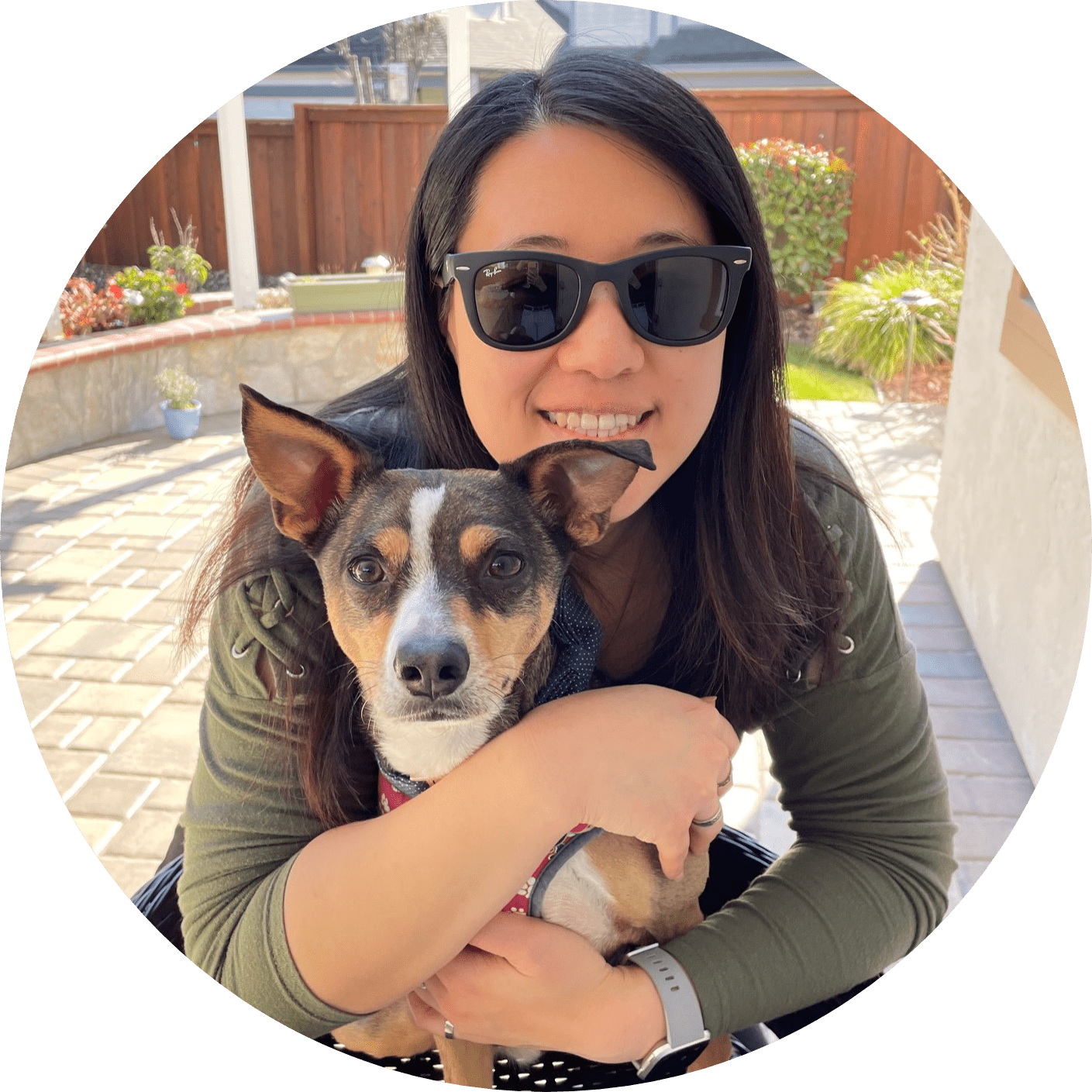
Dr. Sabrina Kong graduated from the Royal Veterinary College in England in 2016 and has been working at a small animal clinic in Northern California since then. She grew up in the Bay Area and got her bachelor’s degree from Cal Poly San Luis Obispo. She also became a Certified Canine Rehabilitation Practitioner through a program at the University of Tennessee.
When she isn’t in the clinic taking care of her four-legged patients, she enjoys traveling and trying new foods with her friends and her three-legged dog, Apollo. She adopted Apollo from her clinic when he was a puppy with numerous health issues. Dr. Kong truly cares about taking care of animals.





